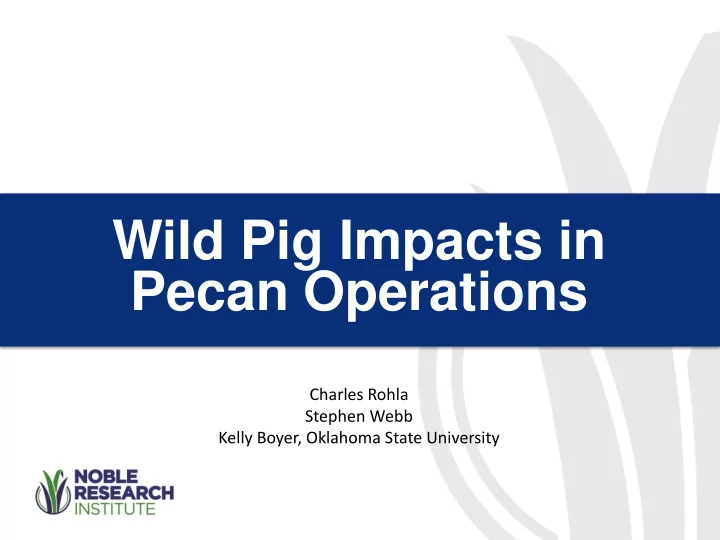

Wild Pig Impacts in Pecan Operations Charles Rohla Stephen Webb Kelly Boyer, Oklahoma State University
Wild Pigs: Where did they come from? • Early European settlers as a food source in the 15oo’s • Sportsmen in the 1930’s • Populations have converged and have continued to grow
Life History of Wild Pigs • Not a Native Species • Wild pigs are opportunistic omnivores Photo: C. ONeal • Highly adaptable to varying environments • Extremely high reproductive rates • Have no natural predators Photo: Z. Johnson
The Problem • Dama amage ge • Depr epreda edation tion • Disease isease • Disturbance isturbance
Why are they a problem? • General foraging behavior such as rooting, digging and wallowing causes damage to pasture land, livestock, lawns and agricultural Photo: Billy Higginbotham, Texas AgriLife Extension crops • USDA has reported a conservative estimate $2.5 Billion in damage and control directly attributed to wild pigs • With $1.5 billion in agricultural loss alone in 2016 Photo courtesy of MDC
Wild Pigs : Pecans • Pecan orchards and groves are attractive resources for many wildlife species • High caloric abundant food source in a season when food can be hard to find • Geographic overlap of the two species, wild pigs and pecans • Foraging behavior leads to damage of pecan operations as well as loss in yields as a result
Objectives: • Determine resource selection by wild pigs in and around pecan orchards and groves in response to timing of pecan harvest • Quantify loss of pecan yields due to wild pig damage
Study Area Noble Research Institute’s Red • River Farm in southern Love County, Oklahoma • Approximately 3200-acre pasture and demonstration farm including 365 acres of harvested pecans • Abundant wild pig population
Methods: Recourse Selection • BoarBuster ™ traps • Captured, collared and released 29 individual adult sows over 2 seasons Photo: R. Matson ( n=16 in 2016, n=13 in 2017) • Target was 2 individuals per sounder • Vectronic Vertex Lite GPS collars with Iridium communication. • Programmed to take 1 GPS location every 30 min
The Process
The Process
The Process
The Process
Methods: Resource Selection • High resolution imagery was heads-up digitized to represent 8 coverage classifications within the study area • Resource selection analysis using generalized linear mixed modeling
Depredation – Pecan Loss
Depredation – Pecan Loss
Methods: loss of pecan • Identified and measured areas of damage caused by wild pigs in pecan orchards and groves • Sampled 0.33m² plots at random within damaged areas; recorded damage depth and number of pecans both pre and post-harvest • Identical sampling in control areas with no damage caused by wild pigs
Results: Pecan loss • We found that the treatment Damaged vs Control was the only significant predictor (F1, 133 = 5.21, P = 0.024) of harvest inefficiency
Results: Pecan loss • Pecan harvest loss for damaged areas (n=111) was 43.65% • Pecan harvest loss for control areas (n= 30) was 9.96% • Net loss of 33.7% as the result of rooting damage
Results: %Damage x % Loss x Operation Size x Production x Price = Loss in $$$
Results: Resource Selection • Study period in 2016 was 76 days (October 10 – December 29) and in 2017, 69 days (October 13 – December 20) • 98.9% fix rate success over 2 year study • 28:29 collars were collected from individuals using GPS and VHF telemetry
Spatial Prediction – Pig Use
Results: Resource Selection • Further analyses on resource selection and temporal use of pecan operations are in progress
Disease Br Bruc ucella ella sp spp. • Pse Pseud udor orabies bies vir virus us • Tular ularemia emia • Por orcine cine r rep eprod oduc ucti tive e an and d • resp espir irator tory y syn syndr drome ome Cha Chaga gas s dise disease ase • Canine Canine ne neosp ospor orosis osis •
Disease Br Bruc ucella ella spp spp. . = = 15 15.5% .5% • Pseud Pseudor orabies vir bies virus us = = 34 34.0% .0% • Tular ularemia emia = = 19 19.9% .9% • Por orcine cine rep eprod oduc uctiv tive an e and d • resp espir irato tory y synd syndrome ome = = 0.26 0.26% Chagas Ch s disea isease se = = 0.0% .0% • Canine Can ine ne neosp ospor orosis osis = = 67 67.2% .2% •
Disease – Wildlife Services Prevalence (%) Pseudorabies --2011-2016 Classical swine fever (0%) Pseudorabies (24.4%) 10.7 14.8 --28,253 pigs removed Swine brucellosis (7.1%) --5,825 tested Influenza A virus (7.2%) 30.3 28.8 Leptospirosis (46.2%) Toxoplasmosis (8.5%) 30.3 31.9 Trichinosis (1.0%) Tuberculosis (0%) Foot and mouth disease (0%) 2011 2012 2013 2014 2015 2016 Hepatitis E (10.9%) Swine Brucellosis African swine fever (0%) 2.7 Salmonella (63.6%) 4.8 Porcine reproductive and 8.3 respiratory syndrome (0.9%) 4.0 9.2 Bluetongue virus (27.0%) 13.3 Senecavirus (0%) 2011 2012 2013 2014 2015 2016
Conclusion & Discussion • Net loss of pecans was found to be 33.7% • Consumption would be additive to over all loss • Damage too severe to harvest
Conclusion & Discussion • Potential for disease contamination • Resource selection will help to mitigate and prioritize areas for control and reduce loss of pecans from wild pigs.
Miscellaneous --Home range size (Sept.-Jan.) = 564 acres (112-1,204) --11 of 16 pigs cross the Red River 80 times (2-11 crossings) --Litter size = 5.3 (2-9) --Genetic analyses = 734 DNA samples --Population monitoring --Digital phenotyping (age & body mass)
Special Thanks • Noble Research Institute • Natural Resource Ecology and Management department of Oklahoma State University • Oklahoma Department of Agriculture, Food, and Forestry • All others that have assisted in this research
slwebb@noble.org ctrohla@noble.org
Recommend
More recommend